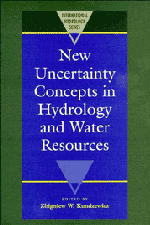Book contents
- Frontmatter
- Contents
- List of Authors
- Preface
- I INTRODUCTION
- II FACETS OF UNCERTAINTY
- III NOVEL APPROACHES TO UNCERTAINTY: FRACTALS, FUZZY SETS AND PATTERN RECOGNITION, NON-PARAMETRIC METHODS
- IV RANDOM FIELDS
- V TIME SERIES AND STOCHASTIC PROCESSES
- 1 Prediction uncertainty in seasonal partial duration series
- 2 A daily streamflow model based on a jump-diffusion process
- 3 The influence of time discretization on inferred stochastic properties of point rainfall
- 4 The distribution of the l-day total precipitation amount
- 5 Analysis of outliers in Norwegian flood data
- 6 Stochastic modelling of the operation of hydrants in an irrigation network
- 7 Order and disorder in hydroclimatological processes
- 8 Towards the physical structure of river flow stochastic process
- VI RISK, RELIABILITY AND RELATED CRITERIA
4 - The distribution of the l-day total precipitation amount
Published online by Cambridge University Press: 07 May 2010
- Frontmatter
- Contents
- List of Authors
- Preface
- I INTRODUCTION
- II FACETS OF UNCERTAINTY
- III NOVEL APPROACHES TO UNCERTAINTY: FRACTALS, FUZZY SETS AND PATTERN RECOGNITION, NON-PARAMETRIC METHODS
- IV RANDOM FIELDS
- V TIME SERIES AND STOCHASTIC PROCESSES
- 1 Prediction uncertainty in seasonal partial duration series
- 2 A daily streamflow model based on a jump-diffusion process
- 3 The influence of time discretization on inferred stochastic properties of point rainfall
- 4 The distribution of the l-day total precipitation amount
- 5 Analysis of outliers in Norwegian flood data
- 6 Stochastic modelling of the operation of hydrants in an irrigation network
- 7 Order and disorder in hydroclimatological processes
- 8 Towards the physical structure of river flow stochastic process
- VI RISK, RELIABILITY AND RELATED CRITERIA
Summary
ABSTRACT On the two-dimensional domain of the time (discrete variable) and the cumulative daily rainfalls (continuous one) an alternating rainfall process is constructed. Methods of renewal theory are used to define the process and to calculate its properties. The fundamental assumption used to derive results of this paper is: the total precipitation amount of the wet days sequence is dependent on the length of this sequence. The independence of the successive dry and wet sequences is assumed too. Based on the above assumptions we finally derive the theoretical distribution of the l-day total precipitation.
INTRODUCTION
Hydrology, from its beginnings, is concerned with rainfall modelling. The importance of precipitation for other hydrological processes caused a stormy development of various models. For a detailed review see for instance the work of Waymire & Gupta (1981). More recent investigations about the properties of daily rainfalls can be divided into three parts:
(a) the seasonal variation of the stochastic model parameters (Woolhiser & Pegram, 1979; Valdes, Rodriguez-Iturbe & Gupta 1985; Yevjevich & Dyer, 1983; Woolhiser & Roldan, 1986);
(b) the description of precipitation occurrence and intensity (Buishand, 1979; Woolhiser & Roldan, 1982);
(c) the construction of models of wet and dry sequences occurrence (Roldan & Woolhiser, 1982; Mimikou, 1983; Jakubowski, 1988).
Unfortunately, though the obtained results are generally more useful than raw observations, they can rarely be applied as an input for simulation models. They do not even give a precise description of the precipitation climatology of a region.
- Type
- Chapter
- Information
- New Uncertainty Concepts in Hydrology and Water Resources , pp. 238 - 244Publisher: Cambridge University PressPrint publication year: 1995



